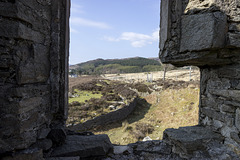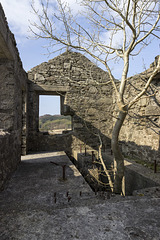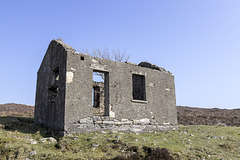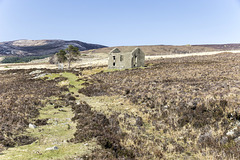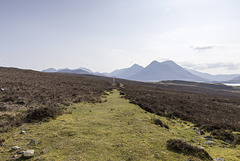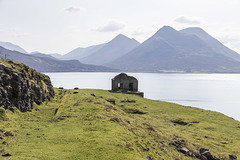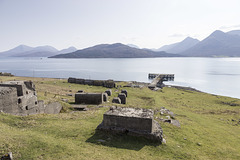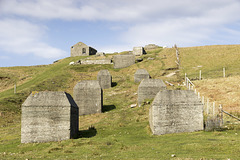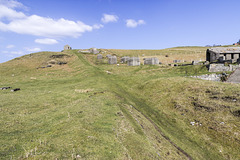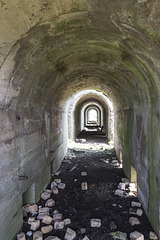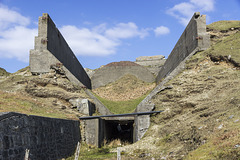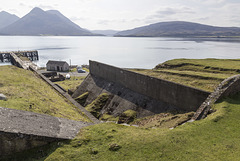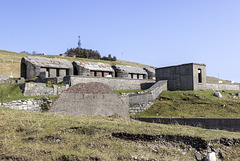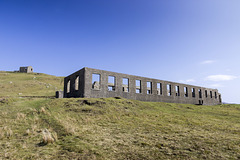
Mines, mining and quarrying
Folder: Mining and quarrying
Raasay: No.2 Mine tramway view from winding house…
| |
|
Raasay Ironstone Mine and Processing Works
This is a view from the No.2 Mine tramway winding house, The tramway and shallow incline runs parallel to the modern fence to the No.2 Mine which was situated in the wooded area in the distance.
Background
The two adits of Raasay No.1 ironstone Mine were situated about 2.5 km north of East Suisnish pier and worked the Jurassic (Upper Lias) age siderite and chamosite ores from 1914 to 1920. The mine was owned and developed by William Baird & Co. who also built the terraces of houses in the village of Inverarish to house the mine workers, many of whom were German prisoners of war. A tramway and incline connected the mine to the processing works (crusher, calcining kilns, gantries, loading hoppers) at East Suisnish.
A second pair of mine adits (Raasay No.2 Ironstone Mine) just north of Inverarish were also opened up around the same time but never went into proper production due to geological difficulties (faulting).
There was also a small amount of opencast outcrop mining carried out near the No.1 Mine, again around the same time.
The works were dismantled by 1943 but the site is now a scheduled protected monument.
A view of the works in 1917 is here:
geoscenic.bgs.ac.uk/asset-bank/action/viewAsset?id=1343
The No.2 Mine entrances in 1917 are shown here:
geoscenic.bgs.ac.uk/asset-bank/action/viewAsset?id=1341
Raasay: No.2 Mine tramway winding house interior
| |
|
Raasay Ironstone Mine and Processing Works
This ruined building was the winding house for the separate tramway up from the No.2 Mine which then joins the main tramway route close to this point. The tree is growing out of the winding wheel pit. The winding ropes passed through the 'L'-shaped hole in the far wall. The No.2 Mine was situated in the wooded area in the far distance.
Background
The two adits of Raasay No.1 ironstone Mine were situated about 2.5 km north of East Suisnish pier and worked the Jurassic (Upper Lias) age siderite and chamosite ores from 1914 to 1920. The mine was owned and developed by William Baird & Co. who also built the terraces of houses in the village of Inverarish to house the mine workers, many of whom were German prisoners of war. A tramway and incline connected the mine to the processing works (crusher, calcining kilns, gantries, loading hoppers) at East Suisnish.
A second pair of mine adits (Raasay No.2 Ironstone Mine) just north of Inverarish were also opened up around the same time but never went into proper production due to geological difficulties (faulting).
There was also a small amount of opencast outcrop mining carried out near the No.1 Mine, again around the same time.
The works were dismantled by 1943 but the site is now a scheduled protected monument.
A view of the works in 1917 is here:
geoscenic.bgs.ac.uk/asset-bank/action/viewAsset?id=1343
The No.2 Mine entrances in 1917 are shown here:
geoscenic.bgs.ac.uk/asset-bank/action/viewAsset?id=1341
Raasay: No.2 Mine tramway winding house
| |
|
Raasay Ironstone Mine and Processing Works
This ruined building was the winding house for the separate tramway up from the No.2 Mine (off to the left) which then joins the main tramway route close to this point.
Background
The two adits of Raasay No.1 ironstone Mine were situated about 2.5 km north of East Suisnish pier and worked the Jurassic (Upper Lias) age siderite and chamosite ores from 1914 to 1920. The mine was owned and developed by William Baird & Co. who also built the terraces of houses in the village of Inverarish to house the mine workers, many of whom were German prisoners of war. A tramway and incline connected the mine to the processing works (crusher, calcining kilns, gantries, loading hoppers) at East Suisnish.
A second pair of mine adits (Raasay No.2 Ironstone Mine) just north of Inverarish were also opened up around the same time but never went into proper production due to geological difficulties (faulting).
There was also a small amount of opencast outcrop mining carried out near the No.1 Mine, again around the same time.
The works were dismantled by 1943 but the site is now a scheduled protected monument.
A view of the works in 1917 is here:
geoscenic.bgs.ac.uk/asset-bank/action/viewAsset?id=1343
Raasay: view north along ironstone mine tramway
| |
|
Raasay Ironstone Mine and Processing Works
This is a norththwards view along the tramway which brought ore down from the mine adits to the processing plant. The camera location is about 1.4 km from the processing plant. The ruined building was the winding house for the separate tramway (of to the left) up from the No.2 Mine to the left) which then joins the main tramway route close to this point.
Background
The two adits of Raasay No.1 ironstone Mine were situated about 2.5 km north of East Suisnish pier and worked the Jurassic (Upper Lias) age siderite and chamosite ores from 1914 to 1920. The mine was owned and developed by William Baird & Co. who also built the terraces of houses in the village of Inverarish to house the mine workers, many of whom were German prisoners of war. A tramway and incline connected the mine to the processing works (crusher, calcining kilns, gantries, loading hoppers) at East Suisnish.
A second pair of mine adits (Raasay No.2 Ironstone Mine) just north of Inverarish were also opened up around the same time but never went into proper production due to geological difficulties (faulting).
There was also a small amount of opencast outcrop mining carried out near the No.1 Mine, again around the same time.
The works were dismantled by 1943 but the site is now a scheduled protected monument.
A view of the works in 1917 is here:
geoscenic.bgs.ac.uk/asset-bank/action/viewAsset?id=1343
Raasay: view south along ironstone mine tramway
| |
|
Raasay Ironstone Mine and Processing Works
This is a southwards view along the tramway which brought ore down from the mine adits to the processing plant. The camera location is about 1.4 km from the processing plant. A separate tramway up from the No.2 Mine joins the main tramway route close to this point.
The Cuillin mountains of Skye are in the background.
Background
The two adits of Raasay No.1 ironstone Mine were situated about 2.5 km north of East Suisnish pier and worked the Jurassic (Upper Lias) age siderite and chamosite ores from 1914 to 1920. The mine was owned and developed by William Baird & Co. who also built the terraces of houses in the village of Inverarish to house the mine workers, many of whom were German prisoners of war. A tramway and incline connected the mine to the processing works (crusher, calcining kilns, gantries, loading hoppers) at East Suisnish.
A second pair of mine adits (Raasay No.2 Ironstone Mine) just north of Inverarish were also opened up around the same time but never went into proper production due to geological difficulties (faulting).
There was also a small amount of opencast outcrop mining carried out near the No.1 Mine, again around the same time.
The works were dismantled by 1943 but the site is now a scheduled protected monument.
A view of the works in 1917 is here:
geoscenic.bgs.ac.uk/asset-bank/action/viewAsset?id=1343
Raasay: Ironstone processing works - southern end…
| |
|
Raasay Ironstone Mine and Processing Works
This is a view from the last section of the tramway which brought ore down from the mine adits to the processing plant. The tramway disappears out of view as it drops steeply down the incline to the processing plant.
The Red Cuillin mountains of Skye are in the background.
Background
The two adits of Raasay No.1 ironstone Mine were situated about 2.5 km north of East Suisnish pier and worked the Jurassic (Upper Lias) age siderite and chamosite ores from 1914 to 1920. The mine was owned and developed by William Baird & Co. who also built the terraces of houses in the village of Inverarish to house the mine workers, many of whom were German prisoners of war. A tramway and incline connected the mine to the processing works (crusher, calcining kilns, gantries, loading hoppers) at East Suisnish.
A second pair of mine adits (Raasay No.2 Ironstone Mine) just north of Inverarish were also opened up around the same time but never went into proper production due to geological difficulties (faulting).
There was also a small amount of opencast outcrop mining carried out near the No.1 Mine, again around the same time.
The works were dismantled by 1943 but the site is now a scheduled protected monument.
A view of the works in 1917 is here:
geoscenic.bgs.ac.uk/asset-bank/action/viewAsset?id=1343
Raasay: Ironstone processing works - view down inc…
| |
|
|
Raasay Ironstone Mine and Processing Works
This is a view down the incline on the last section of the tramway which brought ore down from the mine adits to the processing plant.
The concrete blocks in the foreground are part of the crusher house foundations and just below centre are the gantry supports from which ore would have been transported from the crusher to be fed into the calcining kilns. The gantry and crusher house can be seen in the 1917 photo in the link below. East Suisnish pier and the mountains of Skye are in the background.
Background
The two adits of Raasay No.1 ironstone Mine were situated about 2.5 km north of East Suisnish pier and worked the Jurassic (Upper Lias) age siderite and chamosite ores from 1914 to 1920. The mine was owned and developed by William Baird & Co. who also built the terraces of houses in the village of Inverarish to house the mine workers, many of whom were German prisoners of war. A tramway and incline connected the mine to the processing works (crusher, calcining kilns, gantries, loading hoppers) at East Suisnish.
A second pair of mine adits (Raasay No.2 Ironstone Mine) just north of Inverarish were also opened up around the same time but never went into proper production due to geological difficulties (faulting).
There was also a small amount of opencast outcrop mining carried out near the No.1 Mine, again around the same time.
The works were dismantled by 1943 but the site is now a scheduled protected monument.
A view of the works in 1917 is here:
geoscenic.bgs.ac.uk/asset-bank/action/viewAsset?id=1343
Raasay: Ironstone processing works - concrete gant…
| |
|
Raasay Ironstone Mine and Processing Works
These concrete blocks just above centre originally supported the conveyor gantry from which ore would have been transported from the crusher to be fed into the calcining kilns. Part of the crusher house wall is visible just below the building on the skyline. The gantry and crusher house can be seen in the 1917 photo in the link below.
Background
The two adits of Raasay No.1 ironstone Mine were situated about 2.5 km north of East Suisnish pier and worked the Jurassic (Upper Lias) age siderite and chamosite ores from 1914 to 1920. The mine was owned and developed by William Baird & Co. who also built the terraces of houses in the village of Inverarish to house the mine workers, many of whom were German prisoners of war. A tramway and incline connected the mine to the processing works (crusher, calcining kilns, gantries, loading hoppers) at East Suisnish.
A second pair of mine adits (Raasay No.2 Ironstone Mine) just north of Inverarish were also opened up around the same time but never went into proper production due to geological difficulties (faulting).
There was also a small amount of opencast outcrop mining carried out near the No.1 Mine, again around the same time.
The works were dismantled by 1943 but the site is now a scheduled protected monument.
A view of the works in 1917 is here:
geoscenic.bgs.ac.uk/asset-bank/action/viewAsset?id=1343
Raasay: Ironstone processing works - incline and g…
| |
|
Raasay Ironstone Mine and Processing Works
This is a view up the incline on the last section of the tramway which brought ore down from the mine adits to the processing plant.
The concrete blocks just above centre originally supported the conveyor gantry from which ore would have been transported from the crusher (near the top of the incline) to be fed into the calcining kilns. The gantry and crusher house can be seen in the 1917 photo in the link below.
Background
The two adits of Raasay No.1 ironstone Mine were situated about 2.5 km north of East Suisnish pier and worked the Jurassic (Upper Lias) age siderite and chamosite ores from 1914 to 1920. The mine was owned and developed by William Baird & Co. who also built the terraces of houses in the village of Inverarish to house the mine workers, many of whom were German prisoners of war. A tramway and incline connected the mine to the processing works (crusher, calcining kilns, gantries, loading hoppers) at East Suisnish.
A second pair of mine adits (Raasay No.2 Ironstone Mine) just north of Inverarish were also opened up around the same time but never went into proper production due to geological difficulties (faulting).
There was also a small amount of opencast outcrop mining carried out near the No.1 Mine, again around the same time.
The works were dismantled by 1943 but the site is now a scheduled protected monument.
A view of the works in 1917 is here:
geoscenic.bgs.ac.uk/asset-bank/action/viewAsset?id=1343
Raasay: Ironstone processing works - calcining kil…
| |
|
Raasay Ironstone Mine and Processing Works
This is an interior view of the base of the ore calcining kilns. The five vertical cylindrical kiln structures since demolished would have stood above the gaps where the daylight is now shinging through. The original appearance of the kilns can be seen in the link below.
Background
The two adits of Raasay No.1 ironstone Mine were situated about 2.5 km north of East Suisnish pier and worked the Jurassic (Upper Lias) age siderite and chamosite ores from 1914 to 1920. The mine was owned and developed by William Baird & Co. who also built the terraces of houses in the village of Inverarish to house the mine workers, many of whom were German prisoners of war. A tramway and incline connected the mine to the processing works (crusher, calcining kilns, gantries, loading hoppers) at East Suisnish.
A second pair of mine adits (Raasay No.2 Ironstone Mine) just north of Inverarish were also opened up around the same time but never went into proper production due to geological difficulties (faulting).
There was also a small amount of opencast outcrop mining carried out near the No.1 Mine, again around the same time.
The works were dismantled by 1943 but the site is now a scheduled protected monument.
A view of the works in 1917 is here:
geoscenic.bgs.ac.uk/asset-bank/action/viewAsset?id=1343
Raasay: Ironstone processing works - calcining kil…
| |
|
Raasay Ironstone Mine and Processing Works
These structures are the remains of the ore calcining kilns, though the five vertical cylindrical kiln structures have been demolished. The original appearance of the kilns can be seen in the link below.
Background
The two adits of Raasay No.1 ironstone Mine were situated about 2.5 km north of East Suisnish pier and worked the Jurassic (Upper Lias) age siderite and chamosite ores from 1914 to 1920. The mine was owned and developed by William Baird & Co. who also built the terraces of houses in the village of Inverarish to house the mine workers, many of whom were German prisoners of war. A tramway and incline connected the mine to the processing works (crusher, calcining kilns, gantries, loading hoppers) at East Suisnish.
A second pair of mine adits (Raasay No.2 Ironstone Mine) just north of Inverarish were also opened up around the same time but never went into proper production due to geological difficulties (faulting).
There was also a small amount of opencast outcrop mining carried out near the No.1 Mine, again around the same time.
The works were dismantled by 1943 but the site is now a scheduled protected monument.
A view of the works in 1917 is here:
geoscenic.bgs.ac.uk/asset-bank/action/viewAsset?id=1343
Raasay: Ironstone processing works - ore hopper en…
| |
|
Raasay Ironstone Mine and Processing Works
This is an end view of the remains of the ore hopper. The square opening at the base would have contained the conveyor which would have transferred the ore to the East Suisnish pier for loading on to boats.
Background
The two adits of Raasay No.1 ironstone Mine were situated about 2.5 km north of East Suisnish pier and worked the Jurassic (Upper Lias) age siderite and chamosite ores from 1914 to 1920. The mine was owned and developed by William Baird & Co. who also built the terraces of houses in the village of Inverarish to house the mine workers, many of whom were German prisoners of war. A tramway and incline connected the mine to the processing works (crusher, calcining kilns, gantries, loading hoppers) at East Suisnish.
A second pair of mine adits (Raasay No.2 Ironstone Mine) just north of Inverarish were also opened up around the same time but never went into proper production due to geological difficulties (faulting).
There was also a small amount of opencast outcrop mining carried out near the No.1 Mine, again around the same time.
The works were dismantled by 1943 but the site is now a scheduled protected monument.
A view of the works in 1917 is here:
geoscenic.bgs.ac.uk/asset-bank/action/viewAsset?id=1343
Raasay: Ironstone processing works - ore hopper
| |
|
Raasay Ironstone Mine and Processing Works
This shows the remains of the ore hopper. The row of buildings to the rear are the remains of the ore calcining kilns, though the cylindrical kiln structures have been demolished and the bricks (I suspect) are those now dumped in the ore hopper. The rectangular and sloping structures would have housed the conveyors to transfer calcined ore into the hopper.
Background
The two adits of Raasay No.1 ironstone Mine were situated about 2.5 km north of East Suisnish pier and worked the Jurassic (Upper Lias) age siderite and chamosite ores from 1914 to 1920. The mine was owned and developed by William Baird & Co. who also built the terraces of houses in the village of Inverarish to house the mine workers, many of whom were German prisoners of war. A tramway and incline connected the mine to the processing works (crusher, calcining kilns, gantries, loading hoppers) at East Suisnish.
A second pair of mine adits (Raasay No.2 Ironstone Mine) just north of Inverarish were also opened up around the same time but never went into proper production due to geological difficulties (faulting).
There was also a small amount of opencast outcrop mining carried out near the No.1 Mine, again around the same time.
The works were dismantled by 1943 but the site is now a scheduled protected monument.
A view of the works in 1917 is here:
geoscenic.bgs.ac.uk/asset-bank/action/viewAsset?id=1343
Raasay: Ironstone processing works - ore hopper an…
| |
|
|
Raasay Ironstone Mine and Processing Works
The remains of the ore hopper from which crushed and calcined ore was stored prior to loading via conveyor into boats at the East Suisnish pier. The mountains and hills of Skye are in the distance.
Background
The two adits of Raasay No.1 ironstone Mine were situated about 2.5 km north of East Suisnish pier and worked the Jurassic (Upper Lias) age siderite and chamosite ores from 1914 to 1920. The mine was owned and developed by William Baird & Co. who also built the terraces of houses in the village of Inverarish to house the mine workers, many of whom were German prisoners of war. A tramway and incline connected the mine to the processing works (crusher, calcining kilns, gantries, loading hoppers) at East Suisnish.
A second pair of mine adits (Raasay No.2 Ironstone Mine) just north of Inverarish were also opened up around the same time but never went into proper production due to geological difficulties (faulting).
There was also a small amount of opencast outcrop mining carried out near the No.1 Mine, again around the same time.
The works were dismantled by 1943 but the site is now a scheduled protected monument.
A view of the works in 1917 is here:
geoscenic.bgs.ac.uk/asset-bank/action/viewAsset?id=1343
Raasay: Ironstone processing works - ore hopper an…
| |
|
Raasay Ironstone Mine and Processing Works
The row of pitched roof buildings are the remains of the ore calcining kilns, though the cylindrical kiln structures have been demolished. Below is the semi-circular back wall of the ore hopper.
Background
The two adits of Raasay No.1 ironstone Mine were situated about 2.5 km north of East Suisnish pier and worked the Jurassic (Upper Lias) age siderite and chamosite ores from 1914 to 1920. The mine was owned and developed by William Baird & Co. who also built the terraces of houses in the village of Inverarish to house the mine workers, many of whom were German prisoners of war. A tramway and incline connected the mine to the processing works (crusher, calcining kilns, gantries, loading hoppers) at East Suisnish.
A second pair of mine adits (Raasay No.2 Ironstone Mine) just north of Inverarish were also opened up around the same time but never went into proper production due to geological difficulties (faulting).
There was also a small amount of opencast outcrop mining carried out near the No.1 Mine, again around the same time.
The works were dismantled by 1943 but the site is now a scheduled protected monument.
A view of the works in 1917 is here:
geoscenic.bgs.ac.uk/asset-bank/action/viewAsset?id=1343
Raasay: Ironstone processing works - old office bl…
| |
|
Raasay Ironstone Mine and Processing Works
The old office block at East Suisnish viewed from the tramway incline. The hills of Skye are in the background with the imposing east face of Ben Tianavaig to the right.
Background
The two adits of Raasay No.1 ironstone Mine were situated about 2.5 km north of East Suisnish pier and worked the Jurassic (Upper Lias) age siderite and chamosite ores from 1914 to 1920. The mine was owned and developed by William Baird & Co. who also built the terraces of houses in the village of Inverarish to house the mine workers, many of whom were German prisoners of war. A tramway and incline connected the mine to the processing works (crusher, calcining kilns, gantries, loading hoppers) at East Suisnish.
A second pair of mine adits (Raasay No.2 Ironstone Mine) just north of Inverarish were also opened up around the same time but never went into proper production due to geological difficulties (faulting).
There was also a small amount of opencast outcrop mining carried out near the No.1 Mine, again around the same time.
The works were dismantled by 1943 but the site is now a scheduled protected monument.
A view of the works in 1917 is here:
geoscenic.bgs.ac.uk/asset-bank/action/viewAsset?id=1343
Raasay: Ironstone processing works - old office bl…
| |
|
Raasay Ironstone Mine and Processing Works
South facing side of the old office block at East Suisnish.
Background
The two adits of Raasay No.1 ironstone Mine were situated about 2.5 km north of East Suisnish pier and worked the Jurassic (Upper Lias) age siderite and chamosite ores from 1914 to 1920. The mine was owned and developed by William Baird & Co. who also built the terraces of houses in the village of Inverarish to house the mine workers, many of whom were German prisoners of war. A tramway and incline connected the mine to the processing works (crusher, calcining kilns, gantries, loading hoppers) at East Suisnish.
A second pair of mine adits (Raasay No.2 Ironstone Mine) just north of Inverarish were also opened up around the same time but never went into proper production due to geological difficulties (faulting).
There was also a small amount of opencast outcrop mining carried out near the No.1 Mine, again around the same time.
The works were dismantled by 1943 but the site is now a scheduled protected monument.
A view of the works in 1917 is here:
geoscenic.bgs.ac.uk/asset-bank/action/viewAsset?id=1343
Raasay: Ironstone processing works - old office bl…
| |
|
Raasay Ironstone Mine and Processing Works
Remains of the office block at East Suisnish.
Background
The two adits of Raasay No.1 ironstone Mine were situated about 2.5 km north of East Suisnish pier and worked the Jurassic (Upper Lias) age siderite and chamosite ores from 1914 to 1920. The mine was owned and developed by William Baird & Co. who also built the terraces of houses in the village of Inverarish to house the mine workers, many of whom were German prisoners of war. A tramway and incline connected the mine to the processing works (crusher, calcining kilns, gantries, loading hoppers) at East Suisnish.
A second pair of mine adits (Raasay No.2 Ironstone Mine) just north of Inverarish were also opened up around the same time but never went into proper production due to geological difficulties (faulting).
There was also a small amount of opencast outcrop mining carried out near the No.1 Mine, again around the same time.
The works were dismantled by 1943 but the site is now a scheduled protected monument.
A view of the works in 1917 is here:
geoscenic.bgs.ac.uk/asset-bank/action/viewAsset?id=1343
Jump to top
RSS feed- Latest items - Subscribe to the latest items added to this album
- ipernity © 2007-2024
- Help & Contact
|
Club news
|
About ipernity
|
History |
ipernity Club & Prices |
Guide of good conduct
Donate | Group guidelines | Privacy policy | Terms of use | Statutes | In memoria -
Facebook
Twitter

